|
Climate Change Studies in India with Various Approaches,
Simulation and Modeling
By: Dr. S.B. Pal*
The concentration of CO2 in the atmosphere has risen 30% since the onset of the industrial revolution in the late 18th century. Change has been a consistent feature of the earth's climate. Periods of relatively cool temperatures caused the ice ages. That warm period almost exactly matches the period over which modern agriculture has evolved.
Genesis Technologies is having an energetic team of professionals with Doctorate, Post Doctorate, and Engineering background are closing working with all leading research institutes and developed many projects in the following areas.
-
Climate Change studies
-
Bio-based Energy and Products
-
Emerging Technologies and Products
-
Environmental Analysis
-
Atmospheric and Aerosol Sciences
-
Simulation and modeling on:
-
CO2 elevated Open Top Chamber (OTC).
-
Free Air CO2 Enrichment (FACE).
-
Free Air Temperature Enrichment (FATE).
-
Temp. Gradient Tunnel (TGT).
-
CO2 elevated Elongated Tunnel.
-
Free air CO2 and Ozone Enrichment Technology
CO2 ELEVATED OPEN TOP CHAMBER (OTC) TECHNOLOGY:
The purpose of Open Top Chamber (OTCs) is to study response of plants in high CO2 and other gas in environment with precise control and regulation of desired CO2, Temp and humidity inside the OTCs. Open Top Chambers (OTCs) is an innovative and cost effective approach to investigate effects of elevated CO2, Temperature and Humidity response of plants.In this approach, CO2 gas is supplied to the chambers through CO2 gas cylinders and maintained at set levels using manifold gas regulators, pressure pipelines, solenoid valves, sampler, pump, CO2 analyzer, PC linked supervisory control and data acquisition (SCADA). The data generated by OTCs are more realistic for impact assessment analysis of rising atmospheric CO2 and temperature on plants for developing models to predict the responses for future climatic conditions. The accuracy of the results depends on the system adopted and its maintenance of the required CO2 levels with near natural and variable conditions for other parameters. On the growth dynamics and yield. Open Top Chambers for elevated CO2 study are built with high quality multi layered Polycarbonate sheets (4mm thickness) of 3X3X4mt. dimensions with GI/MS structure with proper foundation and grouting. A suitable door of 6ft X3 ft. size is provided in each chamber. Multilayered clear polycarbonate sheet with 80-85% light transmission level to be used for OTC
structure. Flat and angle aluminium and rust free screws are used for mounting
of polycarbonate sheet. Welding at four corners and inclination of 30� at top is
provided to protect against high winds and moderate vibrations. Sealing of OTC
is achieved using aluminium angles, plates at the top, corners and centre along
with gaskets. Door is sealed using �U� type gaskets with overlapping of sheets
to prevent loss of CO2 through doors.

Fig. 1. Open Top
Chamber with instrumentation
FREE AIR CO2 ENRICHMENT TECHNOLOGY (FACE):
�
Both horizontal & Vertical GI pipes (C class)
are used in hexagonal structure for CO2 release in FACE Ring. Each ring is of 15
ft height and 10 m of diameter. On each arm of FACE ring manual operated valves
at 5 ft gap are used to release CO2 at different heights. Each horizontal and
vertical section of each arm has CO2 releasing nozzles with 0.4mm injection
point to cover maximum area of FACE ring. CO2 sampling tube is placed at three
different locations in FACE ring to pull air sample through air pump to CO2
analyser.
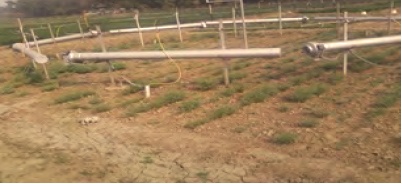
Fig 2.
FACE at IARI ( New Delhi) |

Fig. 3.
FACE system at NBRI, Lucknow to determine and control of CO2
level/concentration in each ring on real time basis |
Wind direction, wind velocity, and [CO2] are
measured and this information is used by a computer-controlled system to adjust
CO2 flow rate to maintain the target elevated [CO2]. Online monitoring options
for temperature, humidity, CO2, wind speed, wind direction and photosynthetic
active radiation (PAR) light intensity sensor are available with the system.
Signal is obtained from these sensor transmitted toward control room through
four core shielded cable.

Fig. 4.
FACE at ICRISAT, Hyderabad |
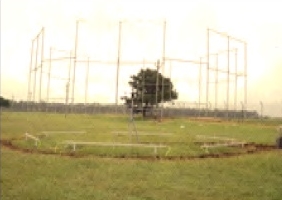
Fig. 5.
FACE at MSSRF, Chennai |
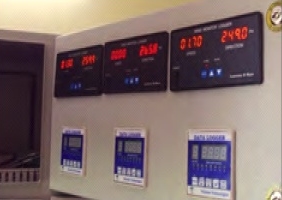
�Fig. 6. FACE and FATE
Control panel |
The equipment for monitoring and controlling CO2 in FACE ring is fully automatic and desired level of CO2 is maintained throughout the experiment inside FACE ring. The system basically consist of CO2 analyzer to measure CO2 coming from field, motor/ aspirator to pump sample from field FACE ring, solenoid valves to regulate CO2 in ppm, Air flow meter, air filter, CO2 gas cylinder for supply of CO2 gas, air compressor to maintain the uniformity of CO2 gas at desired set point, anemometer is use to measure wind speed and direction, relay card is used to operate 230v operated solenoid valve, relay module is use as output of data logger, data logger, SCADA software and PC.
Free Air Temperature Enrichment (FATE) Technology:
Powerful and efficient infrared heaters with quartz IR heating element are used in hexagonal ring to, achieve temp. up to ambient +5Deg C across the open plot area. Temperature and humidity transmitter, portable CO2 monitor, photosynthetically active radiation (PAR) sensor, wind speed and wind direction sensors are placed in each FATE ring. Signals from each sensor are obtained to control room through four core shielded cable for data logging and control option.
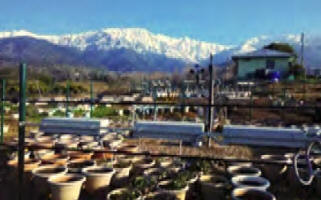
Fig. 7. FATE at IHBT, Palampur |
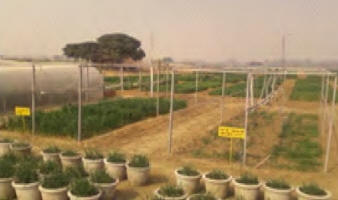
Fig. 8: FATE system at IARI |
Free Air
CO2 and Ozone Enrichment Technology:
Both horizontal & Vertical SS pipes are used in hexagonal structure for CO2 and O3 release in Rings. Each ring is of 10 ft height and 10 m of diameter. On each arm of FACE and Ozone ring Manual operated valves at 5 ft gap are used to release CO2 and O3. Each horizontal and vertical section of each arm has CO2 releasing nozzles of 0.4mm injection point to cover maximum area of FACE and Ozone ring. CO2 and O3 sampling tube is placed at three different locations in FACE and Ozone ring to pull air sample through air pump to CO2 and O3 analyser to determine and control of CO2 and O3 concentration in each ring on real time basis. High volume blower (5000cfm) used to discharge O3 through O3 generator to ozone ring.
Temp. Gradient Tunnel (TGT) with control and automation
Dimension of TGT is 15mt to 50 meter (Length). Sophisticated air blowing/heating facilities for achieving different gradient of 1 to 5 deg C from one end of the tunnel to another end. Polycarbonate sheet of 85% light transmission are being used for covering the system. Temp and Humidity sensors are being mounted at 3mt interval for data logging option and signals from each sensor are being recorded and monitored and controlled by PLC & SCADA system.

Fig. 9.
CO2 and Ozone ring at IARI, (New Delhi) |

Fig. 10.
Temp Gradient Tunnel (TGT) and ET |
Elongated Tunnel and CO2 Gradient Tunnel (ET and CGT):
The chamber is 1.2 m wide, 1.5 m tall, and 60 m long, divided into 10 compartments, each of 5mt long.. Each compartment is made of a rust proof metal structure to provide the above stated housing dimension of uniform size covered by transparent polycarbonate sheet. The polycarbonate sheet is continuous and to provide air tight atmosphere within the chambers except for provisional exits at the two (north and south) ends. Each compartment is separated from adjacent compartments by 1m x 1m sheet metal duct containing chilled air. All the ten compartments are thus connected by joining of the two adjacent compartments, each connected by a 1-m sheet-metal duct connecting to a cooling system. Structure with MS and GI pipe and covered with a polycarbonate sheet of more than 85 % transparency. Sophisticated air blowing facilities for achieving different CO2 gradient of 1 to 5 deg C from one end of the tunnel to another. A dedicated reliable control/ monitoring system are being installed for online monitoring of temperature & humidity with fixed monitoring option in different point across the tunnel.
CONCLUSION
The atmospheric CO2 concentration increasing due to anthropological activities can influence the process of photosynthesis in C3 plants which expected to alter the growth dynamics, structure and functions of terrestrial ecosystems including plant growth, yield, biomass, photosynthesis, transpiration and respiration and nutrient uptake also. It is also projected that changes in plants responsiveness in terms of physiological, biochemical and molecular to elevated atmosphere CO2 may happen. A number of technologies have been developed to study the impact of rising atmospheric CO2 on a plant system and also monitor the carbon exchange processes under changing climate. Here, we tried to focus on effects of elevated CO2 and temperature on forest tree species using OTC and other approaches which are strongly required for developing adaptation and mitigation strategies to address the potential impacts of future climate change. There are so many areas in forestry science such as breeding new varieties against abiotic stress and improved water and nutrient use efficiency, effects of elevated CO2 on host parasite interaction and on insect-pests and diseases and species and ecosystem levels and phyto-remediation potential of tree species under elevated CO2 which might be taken as priority basis with respect to effects of elevated CO2 on growth dynamics, structure and function of plants species using Open Top Chambers (OTCs)., FACE and FATE facilities.
�
*Founder Director,
Genesis Technologies and Genesis Technology Foundation, Genesis House, Plot No. 27, Sector-06, Koparkheriane, Navi Mumbai 400706, MS, India
www.genesisindia.net.in
E-mail: [email protected]
|